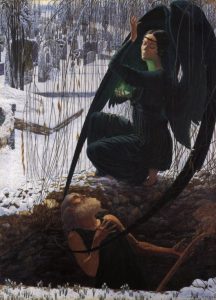The Symbolist Movement
The Symbolist Movement was a late 19th century art movement which greatly influenced literature, the visual arts, music, and theatre. Symbolism can be defined as a reaction against Naturalism and Realism in the arts. Therefore, Symbolists focused on dreams, the imagination, and spirituality. There was a premium placed on mysticism and mythology within their works in a way that differentiated themselves from typical academic artists of the period. It is also critical to note the influence of the Decadent Movement on Symbolism, which placed an emphasis on creativity and expression over Realism. Ultimately, the aim of Symbolist art was to express universal truths, which they believed could only be depicted through metaphorical imagery and suggestive forms containing symbolic imagery.
It is critical to note that the Symbolist Movement did not begin as an art movement, but rather a set of theories and ideologies sprouted by French and Belgian intellectuals which culminated in “”Le Symbolisme,” the Symbolist Manifesto. This intellectual movement would in turn influence the arts and give rise to the artistic movement itself.
Defining characteristics of Symbolist art include the use of esoteric imagery, suggestion of the senses, religion, mysticism, sin, and love. Common themes include Biblical stories, mythology, and legend.

La Mort et le Fossoyeur/Death and the Gravedigger. Carlos Schwabe. 1895.
Russian Symbolism
The Russian Symbolist Movement shared these base features with the Western European Symbolist Movement, which was predominantly in France. Both the Western and Russian iterations of Symbolism believed that only through the interjection of esoteric messages and symbols could they truly depict the subject matter. However, the Russian Symbolist Movement would differentiate itself from the Western Symbolist Movement through its inclusion of themes from Russian folklore, Russian literature, and elements of Byzantine art.

Videnie Otroku Barfolomeyu/The Vision to the Youth Bartholomew. Mikhail Nesterov. Tretyakov Gallery, Moscow.
What The Demon Seated Shows
One of the most significant things that this work by Vrubel illustrates is the “irrationality” that was heralded by the Symbolists. His decision to create a work that would not have resonated with the general public and his view that true art would be perceived as both irrational and incomprehensible illustrates just this. This is amplified by his use of suggestive forms and dream-like visions, illustrated by the hallucinogenic quality of the work.
This work also illustrates how the Russian Symbolist Movement diverged from the Western European iteration. Specifically, the influence of Byzantine art. This piece illustrates the architectural influence of Byzantine art, specifically mosaics and stained glass. The Russian literary tradition also marks one of the biggest diversions from the Western movement. The Demon Seated was inspired by Mikhail Yuryevich Lermontov’s poem Demon. Within the Russian Symbolist Movement, the Russian literary inheritance was emphasized and often the source of inspiration for the works.
Mikhail Vrubel’s The Demon Seated provides an excellent window into examining how these movements diverged stylistically as well as in terms of their influence. Works such as this would have a lasting legacy that would canonize Russia’s position as a critical player in European avant-garde movements through this period and into the 20th century.